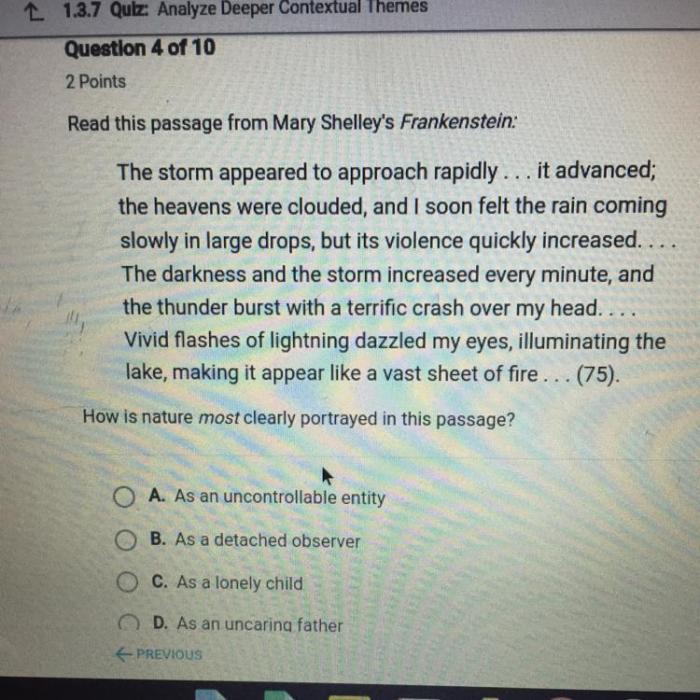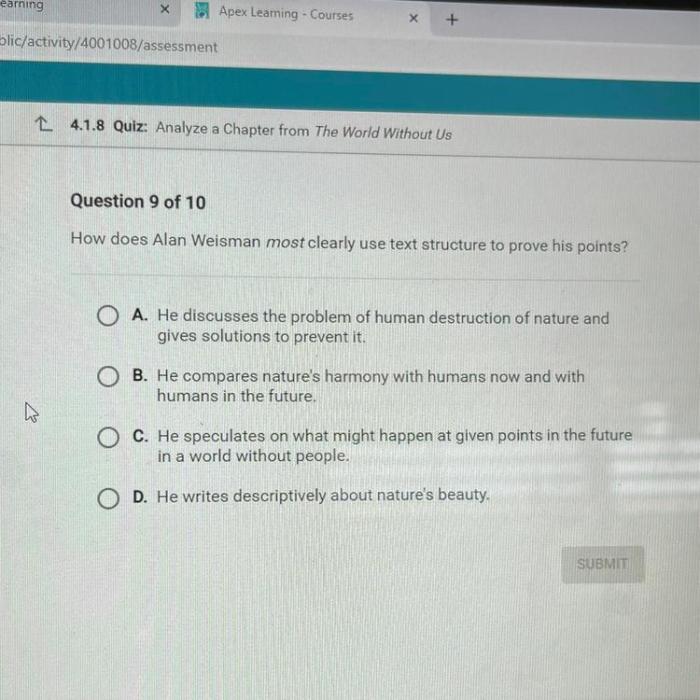How is nature most clearly portrayed in this passage – Delving into the intricate tapestry of this passage, we embark on an exploration of how nature is most clearly portrayed. Through a captivating analysis of sensory imagery, personification, symbolism, and structural elements, we unravel the profound ways in which nature’s essence is brought to life.
Unveiling the depths of nature’s portrayal, we delve into the vivid sensory imagery that paints a vibrant canvas. Figurative language and specific word choice intertwine, creating a symphony of colors, textures, and sounds that transport the reader into the heart of nature’s embrace.
Visual Imagery

The passage employs vivid sensory details to create striking images of nature. Specific word choice and figurative language contribute to this portrayal, such as “the emerald leaves danced in the gentle breeze” and “the towering mountains stood like ancient guardians.”
These visual images evoke a strong sense of nature’s beauty and grandeur, immersing the reader in its vibrant world. They stimulate the reader’s imagination and allow them to experience nature as if they were present.
Personification and Anthropomorphism
The passage often assigns human qualities to natural elements, giving them the ability to think, feel, and act like humans. For instance, “the wind whispered secrets to the trees” and “the river flowed with a gentle sigh.”
These techniques enhance the portrayal of nature by making it more relatable and emotionally resonant. By attributing human characteristics to nature, the passage allows readers to connect with it on a deeper level, understanding its moods and complexities.
Symbolism and Metaphor, How is nature most clearly portrayed in this passage
The passage employs symbols and metaphors to create deeper meanings and connections between nature and other concepts. For example, the “roaring thunder” symbolizes the power of nature, while the “delicate flowers” represent its fragility.
These devices enhance the portrayal of nature by giving it symbolic significance beyond its physical appearance. They allow the reader to contemplate the deeper meanings and connections that nature holds.
Nature’s Impact on Characters
Nature plays a significant role in shaping the thoughts, emotions, and actions of the characters in the passage. For instance, the “tranquil forest” brings peace to the troubled protagonist, while the “raging storm” intensifies their inner turmoil.
By exploring nature’s impact on characters, the passage highlights its power to influence human experience and shape our understanding of the world.
Structural Elements
The organization of the passage contributes to the portrayal of nature. Paragraphs and stanzas are used to create a coherent flow, allowing readers to follow the progression of events and themes.
Literary devices such as foreshadowing, flashbacks, and parallelisms enhance the impact of nature by building anticipation, creating connections, and reinforcing its significance throughout the passage.
Question Bank: How Is Nature Most Clearly Portrayed In This Passage
How does personification contribute to the portrayal of nature?
Personification breathes life into nature, attributing human qualities to non-human entities. This technique fosters an emotional connection between the reader and nature, allowing for deeper comprehension and empathy.
What role do symbols play in representing aspects of nature?
Symbols serve as evocative representations of nature’s complexities. They create profound connections between the natural world and abstract concepts, enriching the interpretation of the passage.
How does the organization of the passage enhance the portrayal of nature?
The passage’s structure, including paragraphs and sections, guides the reader’s journey through nature’s multifaceted tapestry. Foreshadowing, flashbacks, and parallelisms heighten the impact of nature’s presence, creating a cohesive and meaningful experience.

